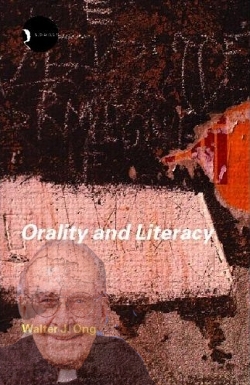 Walter Ong, a Jesuit priest who was based largely at Harvard University, died in 2003, aged 91. His 1982 book, “Orality and Literacy: The Technologizing of the Word”, provides some helpful reflection on the distinctive nature of cultures which have not been totally subsumed by the values of a literacy and mass media. Ong works within a discipline that recognizes the bias we bring to engagement with indigenous cultures, though he himself show evidence of that bias as he writes about cultures with evidence “oral residue”, as if to suggest that they have not yet fully evolved.
Walter Ong, a Jesuit priest who was based largely at Harvard University, died in 2003, aged 91. His 1982 book, “Orality and Literacy: The Technologizing of the Word”, provides some helpful reflection on the distinctive nature of cultures which have not been totally subsumed by the values of a literacy and mass media. Ong works within a discipline that recognizes the bias we bring to engagement with indigenous cultures, though he himself show evidence of that bias as he writes about cultures with evidence “oral residue”, as if to suggest that they have not yet fully evolved.
Physical Presence
It is the vocal delivery of words that gives them power in an oral culture. In an oral culture being physically present is essential to communication. Somebody has to vocalise and embody the message. Somebody needs to physically hear the message. A letter or email does not carry anywhere near the same impact as turning up in person to build the relationship and give the evidence of good will as the foundation of engagement.
So what does this mean in practice? Because communication happens in the context of relationship, meaning is conveyed and interpreted in terms of relationships. What are the stories that connect speakers and listeners? What are the implications for others to whom we must relate what has been talked about? What are the non-verbal cues that communicate much more than the “content” carried in the words?
Memory Assets
Ong points out that in an oral culture meaning is developed by adding rather than analysing. A culture focused on literacy tends to favour linear communication styles that show orders of priority, structures of complexity and relationships between one concept and another. In a more circular approach, we reach a shared understanding by adding stories, phrases and pictures together, again and again. If we want to tell the stories again and again, we need to have well known phrases used as the framework, tying together words that may seem cliched to people trained in a university environment. In a print environment I can go back over text to check on meaning. In a speech environment, I need the speaker to go back over what has been said previously. This is particularly so in large audiences, where people may not hear every word.
Oral cultures, Ong suggests, have a preference for communication that is “close to the human lifeworld”. Concepts need to be embedded in the immediate, familar interaction of human beings. That’s why stories and case studies are so important in this context. Does it make any difference to the way people operate? No? Then who cares?
Songs and proverbs that can be memorised by whole groups of people. Litanies which, despite the name, are usually memorised from speech rather than learnt from paper.
Here’s Walter Ong’s list of headings, as they are written in his book.
1. Additive rather than subordinative
2. Aggregative rather than analytic
3. Redundant or ‘copious’
4. Conservative or traditionalist
5. Close to the human lifeworld
6. Agonistically toned
7. Empathetic and participatory rather than objectively distanced
8. Homeostatic
9. Situational rather than abstract
Blue Collar Culture
Tex Sample helpfully connects Ong’s insights in his exploration of blue collar culture in the United States, reminding us that the academic frame of mind is not universally applied in any culture. He suggests that every people group have at the heart an oral culture, which in some cases is discouraged or suppressed through a focus on written language and abstract discourse. See more on his approach in the two books, “Ministry in an Oral Culture: Will Rogers, Uncle Remus & Minnie Pearl”, and “Blue Collar Ministry”.
